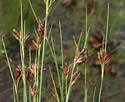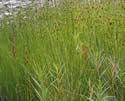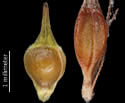Rhynchospora fusca (Brown Beaksedge)
| Also known as: | Brown Beakrush, Sooty-colored Beakrush |
|---|---|
| Genus: | Rhynchospora |
| Family: | Cyperaceae (Sedge) |
| Life cycle: | perennial |
| Origin: | native |
| Habitat: | sun; wet sandy or peaty soil; bogs, floating mats, marshy meadows, shores, swales, marly pools |
| Fruiting season: | July - September |
| Plant height: | 6 to 16 inches |
| Wetland Indicator Status: | GP: OBL MW: OBL NCNE: OBL |
| MN county distribution (click map to enlarge): |  |
| National distribution (click map to enlarge): |  |
Pick an image for a larger view. See the glossary for icon descriptions.
Detailed Information
Flower: 

![[photo of spikelet clusters]](/udata/r9ndp23q/pd3/rhynchospora-fusca-081916-27-t.jpg) One to 3 inverted cone-shaped to hemispheric clusters at the tip of the stem, each up to 1 cm (3/8 inch) across, usually with 1 or 2 smaller, lateral clusters widely separated on the upper half of the stem. Each cluster is on an erect stalk with a leaf-like or bristle-like bract at the base, the bract usually longer than the attending cluster. Each cluster has several to many red-brown to deep brown spikelets (flower clusters).
One to 3 inverted cone-shaped to hemispheric clusters at the tip of the stem, each up to 1 cm (3/8 inch) across, usually with 1 or 2 smaller, lateral clusters widely separated on the upper half of the stem. Each cluster is on an erect stalk with a leaf-like or bristle-like bract at the base, the bract usually longer than the attending cluster. Each cluster has several to many red-brown to deep brown spikelets (flower clusters).
![[close-up of spikelet cluster]](/udata/r9ndp23q/pd3/rhynchospora-fusca-081916-s3-t.jpg) Spikelets are stalkless or nearly so, 4 to 6 mm long (to ¼ inch), lance-shaped, pointed at the tip, with 2 or 3 perfect flowers (both male and female parts), each subtended by a scale; the lowest scale is often empty. Flowers have 3 stamens and a 2-parted style. Scales are 4 to 5 mm long, lance-shaped, pointed at the tip, the midrib often extended as an awn.
Spikelets are stalkless or nearly so, 4 to 6 mm long (to ¼ inch), lance-shaped, pointed at the tip, with 2 or 3 perfect flowers (both male and female parts), each subtended by a scale; the lowest scale is often empty. Flowers have 3 stamens and a 2-parted style. Scales are 4 to 5 mm long, lance-shaped, pointed at the tip, the midrib often extended as an awn.
Leaves and stems: 


![[photo of rusty colored sheath]](/udata/r9ndp23q/pd3/rhynchospora-fusca-081916-s16-t.jpg) Leaves are alternate and basal, erect to ascending to arching, hairless, wiry with rolled-in edges (involute), up to 1.5 mm wide, shorter than the flowering stem and the upper stem leaves usually not over-topping the terminal cluster. Sheaths are closed, more or less straight across at the tip, membranous and greenish to rusty brown on the front. Stems are very slender, 1 mm diameter or less, erect to curved, unbranched, nearly round in cross-section, hairless, green, leafy, and multiple from the base forming clumps, sometimes forming mats from creeping rhizomes.
Leaves are alternate and basal, erect to ascending to arching, hairless, wiry with rolled-in edges (involute), up to 1.5 mm wide, shorter than the flowering stem and the upper stem leaves usually not over-topping the terminal cluster. Sheaths are closed, more or less straight across at the tip, membranous and greenish to rusty brown on the front. Stems are very slender, 1 mm diameter or less, erect to curved, unbranched, nearly round in cross-section, hairless, green, leafy, and multiple from the base forming clumps, sometimes forming mats from creeping rhizomes.
Fruit: 
![[photo of scales and achenes]](/udata/r9ndp23q/pd3/rhynchospora-fusca-081916-s5-t.jpg) Spikelets produce 2 or 3 achenes (seeds), about 2.5 mm long, flattened lens-shaped in cross-section, resembling an upside-down pear in outline, widest above the middle (obovoid), the base abruptly narrowed but lacking an elongated stalk-like appendage (stipe), and the persistent style forming a narrowly triangular beak at the tip up to 1.3 mm long. Surrounding the base are 5 or 6 barbed bristles of varying lengths, from shorter than to much longer than the achene, including the beak, the barbs pointing upward (good magnification required to see).
Spikelets produce 2 or 3 achenes (seeds), about 2.5 mm long, flattened lens-shaped in cross-section, resembling an upside-down pear in outline, widest above the middle (obovoid), the base abruptly narrowed but lacking an elongated stalk-like appendage (stipe), and the persistent style forming a narrowly triangular beak at the tip up to 1.3 mm long. Surrounding the base are 5 or 6 barbed bristles of varying lengths, from shorter than to much longer than the achene, including the beak, the barbs pointing upward (good magnification required to see).
Notes:
Rhynchospora fusca is a wetland species typically found in peaty soils and reaches the southwestern edge of its US range in northern Minnesota. According to the DNR, it was first discovered in 1950, thought to be restricted to water tracks in large, patterned peatland complexes, and was consequently listed as a Special Concern species in 1984. Subsequent biological surveys showed it was not as rare as first believed so was delisted in 2013.
Rhynchospora fusca may be mistaken for one of the other Rhynchospora species in Minnesota, most of which have broader, flat leaves (at least at the base) and stouter stems. R. capillacea is most similar, also having slender stems and slender, involute leaves, but leaves are even narrower (only to .5mm) and more thread-like, achenes have an elongated, stalk-like base, the barbs on its achene bristles point downward rather than upward (good magnification required to see), and the ranges of these two species do not generally overlap, with R. capillacea present mostly in calcareous fens of prairie regions west of the Mississippi River.
Native Plant Nurseries, Restoration and Landscaping Services ↓
More photos
 Rhynchospora fusca plants
Rhynchospora fusca plants Rhynchospora fusca plants
Rhynchospora fusca plants Rhynchospora fusca habitat
Rhynchospora fusca habitat Rhynchospora fusca with Eriocaulon aquaticum
Rhynchospora fusca with Eriocaulon aquaticum Rhynchospora fusca with Rhynchospora alba
Rhynchospora fusca with Rhynchospora alba comparison of Rhynchospora fusca and R. capillacea achenes
comparison of Rhynchospora fusca and R. capillacea achenes
Photos by Peter M. Dziuk taken in Lake County.
Comments
Have you seen this plant in Minnesota, or have any other comments about it?






